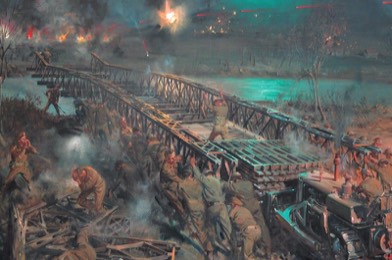The Royal Monmouthshire Royal Engineers (Militia)
-
The World Wars
During the First World War the Regiment provided 76 officers and 2113 men for service on the Western Front, and in Gallipoli, the Middle East, and Italy. They formed four Siege Companies, two Railway Companies and two Army Troops Companies, while a Depot Company in Monmouth recruited and trained new men. Siege companies concentrated on fortifications, railway companies helped to run a narrow gauge network across the battlefield, and Army Troops companies assisted the forward passage of supplies. Medals awarded included 5 DSOs, 8 MCs, 12 DCMs and 16 MMs. One third of the deaths occurred in the final month of the war.
The Regiment was mobilised again on the outbreak of World War Two in September 1939. 100 Company and 101 Company soon deployed to France and were attached to the headquarters of the British Expeditionary Force. Following the German onslaught in May 1940 both companies performed valuable work delaying the enemy by blowing up bridges and fuel stores. Many of 100 Company were captured and spent the remainder of the war as POWs, but 101 Company largely managed to reach Dunkirk and were evacuated from the beaches.
Back in Britain both companies were reformed, undertaking tasks throughout the UK, and later joined VIII Corps to prepare for the Invasion of Europe. Within a month of D-Day both Companies were back in France playing an active role in the breakout from Normandy.
The Regiment was mobilised again on the outbreak of World War Two in September 1939. 100 Company and 101 Company soon deployed to France and were attached to the headquarters of the British Expeditionary Force. Following the German onslaught in May 1940 both companies performed valuable work delaying the enemy by blowing up bridges and fuel stores. Many of 100 Company were captured and spent the remainder of the war as POWs, but 101 Company largely managed to reach Dunkirk and were evacuated from the beaches.
Back in Britain both companies were reformed, undertaking tasks throughout the UK, and later joined VIII Corps to prepare for the Invasion of Europe. Within a month of D-Day both Companies were back in France playing an active role in the breakout from Normandy.

Bridging the Rapido by T Cuneo…………….….The Institution of Royal Engineers
The Companies were especially skilled in the construction of long Bailey Bridges over major rivers and canals, and once the Rhine was crossed in March 1945 the Allies advanced rapidly across Germany. The Regiment built bridges across the Weser and Elbe Rivers, and had reached the Baltic by the end of the War.

